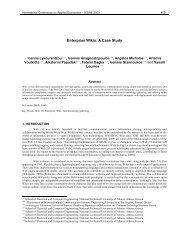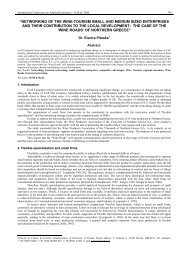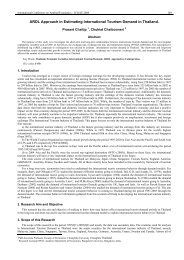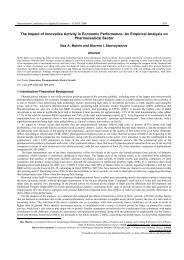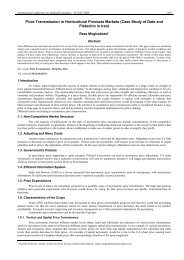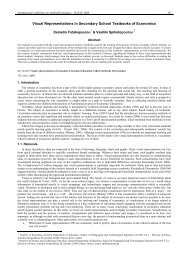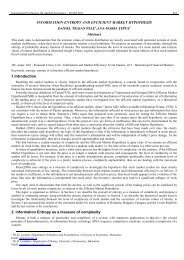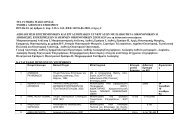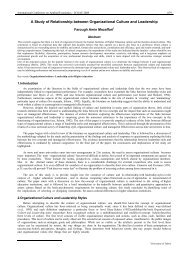Corruption in Indonesia: Does Grease Hypothesis Hold?
Corruption in Indonesia: Does Grease Hypothesis Hold?
Corruption in Indonesia: Does Grease Hypothesis Hold?
You also want an ePaper? Increase the reach of your titles
YUMPU automatically turns print PDFs into web optimized ePapers that Google loves.
International Conference on Applied Economics – ICOAE 2008 783<br />
<strong>Corruption</strong> <strong>in</strong> <strong>Indonesia</strong>: <strong>Does</strong> <strong>Grease</strong> <strong>Hypothesis</strong> <strong>Hold</strong>?<br />
Rivayani 1<br />
Abstract<br />
This paper focus on corruption behavior of officials that h<strong>in</strong>dered <strong>in</strong>vestors <strong>in</strong> <strong>Indonesia</strong>, a country that has been identified as country with low ranks of<br />
<strong>Corruption</strong> Perception Index (CPI). The paper will test the grease hypothesis, argues that bribes can grease economy, particularly under certa<strong>in</strong> level of<br />
rules and regulation imposed by the government. Us<strong>in</strong>g data of 600 large manufacture firms <strong>in</strong> <strong>Indonesia</strong>, several models are estimated us<strong>in</strong>g logit<br />
method. In a chronic case of corruption, all firms will compete to give bribes to the officials, thus <strong>in</strong>creases the official’s barga<strong>in</strong><strong>in</strong>g power. Incorporat<strong>in</strong>g<br />
this competitiveness argument will allow us to measure level of bribes that a firm is will<strong>in</strong>g to pay <strong>in</strong> order to speed the bureaucracy l<strong>in</strong>e. However, this<br />
method also confirmed that grease hypothesis does not hold <strong>in</strong> any case, and shown that corruption <strong>in</strong> <strong>Indonesia</strong> is really a chronic case.<br />
Key Words: <strong>Corruption</strong>, Firms<br />
JEL codes: O120<br />
1. Introduction<br />
In economic term, corruption is def<strong>in</strong>ed as any activities that charges government property for personal benefit. Instead of charg<strong>in</strong>g<br />
the formal price for provid<strong>in</strong>g permits, licenses, or any other public services, corrupt officials often ask additional payment. This<br />
additional payment is so-called bribes.<br />
In measur<strong>in</strong>g level of corruption there is several factors that can be blamed of: lack of government <strong>in</strong>stitution, lower benefit received<br />
by government officials, and the government system adopted are amongst the causal factors of corruption. The corruption itself most<br />
likely happen <strong>in</strong> develop<strong>in</strong>g countries, where the <strong>in</strong>stitution is <strong>in</strong>efficient, the bureaucracy is cumbersome and politics is unstable. 2 It is<br />
already broadly perceived that corruption has negative consequences for economic growth, distort competition and thereby deterr<strong>in</strong>g<br />
<strong>in</strong>vestment.<br />
In <strong>Indonesia</strong>, corruption has become a major issue, where accord<strong>in</strong>g to <strong>Corruption</strong> Perception Index (CPI)-published annually by<br />
Transparency International (TI)-the country always got bottom ranks. After economic crisis <strong>in</strong> 1997 <strong>Indonesia</strong> can’t afford to attract<br />
<strong>in</strong>vestor to comeback. While some countries have shown improvement <strong>in</strong> their economic key <strong>in</strong>dicator, <strong>Indonesia</strong> is the only country that<br />
follows different path where <strong>Indonesia</strong>’s government cannot perform a favorable bus<strong>in</strong>ess climate for <strong>in</strong>vestors. <strong>Corruption</strong> <strong>in</strong> <strong>Indonesia</strong><br />
has attack all sector, discourage private <strong>in</strong>vestment and thus, long run growth prospects.<br />
This paper has three objectives. First, it is tried to analyze the behavior of corruption <strong>in</strong> <strong>Indonesia</strong>, particularly to identify the<br />
characteristics of firms that have high probability to pay bribes to officials. Second, try to answer on how much do those firms paid<br />
bribes. The <strong>in</strong>terest<strong>in</strong>g issue here is, does firms that have higher probability <strong>in</strong> pay<strong>in</strong>g bribes also have a tendency to pay more bribes.<br />
Third, this study will test the grease hypothesis of corruption at firm level for <strong>Indonesia</strong>.<br />
This paper is organized as follows. In the next part, literature reviews on the behavior of corruption, particularly bribery between<br />
firms and officials will be discussed. Part three discusses on how the corruption <strong>in</strong> <strong>Indonesia</strong> is, show<strong>in</strong>g descriptive analysis on how<br />
corruption has impede economic <strong>in</strong>dicator <strong>in</strong> <strong>Indonesia</strong>. In part four, this study will expla<strong>in</strong> the model specification, data, and<br />
methodology used. It also will show thus analyze the result. The last part will be the conclusion.<br />
2. <strong>Corruption</strong>, Growth, and Firms<br />
In recent years, there has been considerable debate on the effect of corruption to economic growth that had motivated many studies.<br />
One hypothesis underly<strong>in</strong>g the analysis is called efficient grease hypothesis. Firstly <strong>in</strong>troduced by Leff (1964), this hypothesis argues that<br />
corruption can grease economy, particularly under certa<strong>in</strong> level of rules and regulation (red tape) imposed by government. It perceived<br />
that corruption might be beneficial under <strong>in</strong>efficient bureaucracy. This hypothesis has been tested us<strong>in</strong>g different method and data set.<br />
Meon and Weill (2005) tests whether corruption can be viewed as the grease of economy us<strong>in</strong>g panel data of 62 countries. They f<strong>in</strong>d that<br />
corruption might grease the economy <strong>in</strong> the country where the <strong>in</strong>stitution is <strong>in</strong>effective.<br />
On the other hand, earlier study by Mauro (1995), didn’t f<strong>in</strong>d any evidence that corruption can be seen as grease of the economy. He<br />
studied the channel on how corruption affects economic growth. He tries to f<strong>in</strong>d this corruption effects by us<strong>in</strong>g corruption-rank<strong>in</strong>g data<br />
of 68 countries dur<strong>in</strong>g 1980-1983. In order to avoid endogeneity problem, he use 2SLS method <strong>in</strong> estimat<strong>in</strong>g the affect of corruption to<br />
<strong>in</strong>vestment and growth. As the <strong>in</strong>strument variable, he use ELF <strong>in</strong>dex, Ethnol<strong>in</strong>guistic Fractionalization. This <strong>in</strong>dex is constructed to<br />
provide an ethnol<strong>in</strong>guistic composition of world population, ma<strong>in</strong>ly based on the criteria of historical l<strong>in</strong>guistic orig<strong>in</strong>. Thus, ELF<br />
measures the fragmentation of population with<strong>in</strong> a country. Therefore, the more fragmented a country, the higher ELF <strong>in</strong>dex would be.<br />
In the regression results, Mauro found a negative correlation between corruption and <strong>in</strong>vestment and growth.<br />
To check the robustness, he controls some other determ<strong>in</strong>ants that could affect <strong>in</strong>vestment and growth, such as population growth,<br />
education, government expenditure, <strong>in</strong>itial GDP, etc. The <strong>in</strong>tuition is quite clear. <strong>Corruption</strong> can decrease <strong>in</strong>centives and opportunities to<br />
<strong>in</strong>vest, thereby lower<strong>in</strong>g economic growth. The ma<strong>in</strong> problem <strong>in</strong> this research is whether ELF is a strong and valid <strong>in</strong>struments variable<br />
for the corruption <strong>in</strong> growth and <strong>in</strong>vestment regression. He <strong>in</strong>deed expla<strong>in</strong>s that there is quite evidence that the ELF is strongly correlated<br />
with the corruption <strong>in</strong>dex <strong>in</strong> one country but at the same time we could also suspect that there is a correlation between the ELF to<br />
<strong>in</strong>vestment also to growth. The more heterogenic a society, the more fragile the social cohesion <strong>in</strong> that country, thus the dispute between<br />
ethnic groups will be or more likely to occurs. These ethnic problems will affect the <strong>in</strong>vestment decision and economic growth. S<strong>in</strong>ce<br />
there would be a correlation between the ELF and Investment and Growth, the ELF could not be seen as a strong and conv<strong>in</strong>c<strong>in</strong>g<br />
<strong>in</strong>strument variable. Therefore, the 2SLS regressions us<strong>in</strong>g ELF as <strong>in</strong>strument variable econometrically could lead <strong>in</strong>to <strong>in</strong>consistent<br />
parameter, thus mislead<strong>in</strong>g conclusion.<br />
The study by Mauro (1995) was confirmed by Kaufman and Wei (2000), who f<strong>in</strong>d that firms who pay more <strong>in</strong> bribes are also likely<br />
to spend more, not less, management time with bureaucrats for negotiat<strong>in</strong>g regulations. In test<strong>in</strong>g this hypothesis, they propose an<br />
1 Researcher and Lecturer, Institute for Economic and Social Research, Department of Economics, University of <strong>Indonesia</strong>.<br />
2 Mauro, Paulo (1995), <strong>Corruption</strong> and Growth, Quarterly Journal of Economics, 110, 681-712
784 International Conference on Applied Economics – ICOAE 2008<br />
empirical model, by us<strong>in</strong>g management time wasted with government officials as the dependent variable, and prevalence of bribes as the<br />
ma<strong>in</strong> explanatory variables. Further study by Henderson, J.V. and A. Kuncoro (2004) also found a positive correlation between time<br />
spend with government officials and amount of bribery. They argue that bribes and management time spent <strong>in</strong> deal<strong>in</strong>g with government<br />
officials has complementary relationship. Firms pay<strong>in</strong>g more bribes to speed up the activity, but they still have to experience time with<br />
local officials to ma<strong>in</strong>ta<strong>in</strong> good relationship with government officials. Svenson (2002) f<strong>in</strong>ds that senior management <strong>in</strong> firms report<strong>in</strong>g<br />
bribes; spend more time deal<strong>in</strong>g with officials.<br />
The evidence from studies above maybe <strong>in</strong>consistent s<strong>in</strong>ce firms are pay<strong>in</strong>g bribes to reduce time spent with government officials to<br />
deal with regulations. One th<strong>in</strong>g that may cause this ambiguity is omitted variable problem. It is possible that large firm with higher<br />
profit more likely to have a lot of supervision from government officials. In that case, these firms <strong>in</strong>deed will spend more time with<br />
government officials, and also higher bribes to smooth<strong>in</strong>g the regulations imposed. Another critical issue of the methodology used by<br />
Henderson and Kuncoro, is randomness of transfer assignment among regions. Random assignment ensures the <strong>in</strong>dependency of<br />
treatment and potential outcomes. S<strong>in</strong>ce the amount of transfer is not random, which depend on the regions characteristics (richer regions<br />
will have higher transfer) then treatment evaluation method may lead the analysis <strong>in</strong>to an <strong>in</strong>consistent and bias parameter.<br />
How much the bribe does should be paid? F<strong>in</strong>d<strong>in</strong>gs on the amount of bribes paid are different between relevance studies, s<strong>in</strong>ce the<br />
studies are us<strong>in</strong>g different micro level data and method. Studies by Svenson (2002) f<strong>in</strong>ds that the amount of bribes depend positively with<br />
the ability of firms to pay, “the more a firm can pay, the more it has to pay”. It can be said that civil servants spend time <strong>in</strong> learn<strong>in</strong>g about<br />
their “customers” and adapt their bribe requests accord<strong>in</strong>gly. He found evidence that the amount of bribes needs to pay depend positively<br />
on current and expected profits, where higher profit today or future will decrease barga<strong>in</strong> power of firms <strong>in</strong> fac<strong>in</strong>g corrupt officials, then<br />
will <strong>in</strong>crease amount of bribes. Moreover, they also f<strong>in</strong>d two important f<strong>in</strong>d<strong>in</strong>gs that amount of bribes depend negatively on alternative<br />
return of capital. So, hav<strong>in</strong>g technology with a low sunk cost will <strong>in</strong>crease firms barga<strong>in</strong><strong>in</strong>g position, so officials will demand lower<br />
bribes. The model assumed that government has perfect <strong>in</strong>formation about firms profit structure, which didn’t happen <strong>in</strong> the reality.<br />
3. <strong>Corruption</strong> <strong>in</strong> <strong>Indonesia</strong><br />
<strong>Indonesia</strong> is rout<strong>in</strong>ely perceived to be one country that has a really serious problem <strong>in</strong> corruption. Based on Transparency<br />
International <strong>in</strong>dex, <strong>Indonesia</strong>’s rank is always stands <strong>in</strong> the bottom, where <strong>in</strong> 2005 it was placed <strong>in</strong> ranks 137 over 145. This condition<br />
gives a huge impact on <strong>Indonesia</strong>’s economic development. It is not only distort competition, discourage <strong>in</strong>vestment, but also can be a<br />
burden for democracy and the rule and law, thus gives negative effect <strong>in</strong> most social <strong>in</strong>dicator.<br />
After economic crisis <strong>in</strong> 1997, <strong>Indonesia</strong> decentralized its government structure by giv<strong>in</strong>g more authority to local government to<br />
manage its <strong>in</strong>come and expenditure. This condition gives a quite significant impact for the rates of corruption, s<strong>in</strong>ce it is not only<br />
decentralized the government structure, but also decentralize the corruption itself. Study by SMERU (2001) shows that after<br />
decentralization, local government creates hundred of regulations concern<strong>in</strong>g taxes, levies and also various policies to regulate bus<strong>in</strong>ess<br />
activity. This <strong>in</strong> turn will cause a negative effect on bus<strong>in</strong>ess climate, where hav<strong>in</strong>g more regulation and rules makes firms are enforced<br />
to face a higher cost. Study by Asian Development Bank (2003) and LPEM-FEUI (2005) found that corruption has been one of the<br />
biggest constra<strong>in</strong>ts for firms, besides macroeconomic <strong>in</strong>stability and policy uncerta<strong>in</strong>ty. Beside those big three, other major constra<strong>in</strong>ts<br />
<strong>in</strong>clude: the legal system, <strong>in</strong>frastructure, taxes, labor skills and labor regulations, cost of f<strong>in</strong>ance, customs and trade regulations and<br />
licenses and permits. Moreover, there is a significant decrease of corruption key variable <strong>in</strong> <strong>Indonesia</strong> between 2001 and 2005 through a<br />
different survey <strong>in</strong> respective years. The level of bribes is decreas<strong>in</strong>g from 10.8 percent <strong>in</strong> 2001 to 1.8 percent <strong>in</strong> 2005, and time spend<br />
with local government is decreases from 12.8 percent <strong>in</strong> 2001 to 4.9 percent <strong>in</strong> 2005. Level of bribes is measured by the ratio of bribes<br />
per cost.<br />
4. Model Specification<br />
In order to identify the probabilities of bribery <strong>in</strong>cidence, specifically to know the characteristics of firms that have a higher<br />
probability <strong>in</strong> pay<strong>in</strong>g bribes, this paper will use the model specification as follows, where i represent firms:<br />
Pi = β Z i + β Oi<br />
+ β Li<br />
+ ε (1)<br />
1 2 3 i<br />
Dependent variable Pi is the outcome variable, which is a categorical variable that represents the <strong>in</strong>tensity of bribery <strong>in</strong>cidence to<br />
happen, based on firms perception <strong>in</strong> <strong>Indonesia</strong> dur<strong>in</strong>g 2004. To estimate this variable, we put explanatory variable <strong>in</strong> the right hand side.<br />
Variable Zi is a vector variable of firm’s characteristics that conta<strong>in</strong> several variables as follow: Custom, EPZ, Year, Tax refund, Labor,<br />
and Sectors dummy. Variable Oi represents number of officials’ type that visits the firms, while Li represents dummy for locations. Thus,<br />
εi represents the error term.<br />
In order to capture the variations of bribery between sectors, we put sector dummy <strong>in</strong> the sample frame. S<strong>in</strong>ce there are n<strong>in</strong>e sectors,<br />
then it can be made for eight sector dummy <strong>in</strong> the model specification. The <strong>in</strong>clusion of this dummy variable is to know which sectors<br />
that have a particular characteristic that can make the probability of bribery <strong>in</strong>cidence higher.<br />
Besides firms’ characteristics, the model specifications also use variable officials (Oi) as a measure of officials’ type that visits firms<br />
<strong>in</strong> 2004. They are come from village district, sub-district, labor office, <strong>in</strong>dustry office, police/army, tax office, custom office, etc. Their<br />
<strong>in</strong>tentions are check<strong>in</strong>g licenses; <strong>in</strong>form new regulation, check<strong>in</strong>g labor and factory condition, etc. It is hypothesized that the higher<br />
number of different official type visited firms, the higher bribery <strong>in</strong>cidence probability that might happen. This variable is considered as<br />
an exogenous variable; s<strong>in</strong>ce which type of officials that comes to the company is based on regulations applied. Variations across<br />
different city were captured by dummy for locations (Li). The <strong>in</strong>clusion of this dummy variable is very important, especially to assess<br />
location variables to capture behavior of local government <strong>in</strong> ask<strong>in</strong>g bribes to the firms located <strong>in</strong> their region. By this, it is expected that<br />
we can have a different result for each region.<br />
S<strong>in</strong>ce variable Pi is the firm’s response on bribery, it is very difficult to get the precise answer. Ask<strong>in</strong>g bribery is very sensitive and<br />
respondents are reluctant to give their <strong>in</strong>formation. In the questionnaire it was asked the <strong>in</strong>tensity of bribery <strong>in</strong>cidence takes place <strong>in</strong> the<br />
company. In order to get the response, it gives six options: never, very seldom, seldom, not that often, often and frequently. This variable<br />
becomes our categorical dependent variable Pi, <strong>in</strong> which estimat<strong>in</strong>g this variable <strong>in</strong> equation (1) with l<strong>in</strong>ear regression is not appropriate.<br />
The method go<strong>in</strong>g to be applied <strong>in</strong> this study is ordered logit model. After us<strong>in</strong>g this method, we could <strong>in</strong>terpret variable Pi as the<br />
probability of bribery <strong>in</strong>cidence.<br />
Another question that we try to answer is what affects the amount of bribery that firms decided to pay. We could use a similar equation with the<br />
first specification, but <strong>in</strong> different dependent variable:
International Conference on Applied Economics – ICOAE 2008 785<br />
Bi = β + β Zi<br />
+ β Oi<br />
+ β Li<br />
+ ε (2)<br />
1 2 3 4 i<br />
The notation and specification use <strong>in</strong> this model are the same as equation (1), except that Bi is the amount of bribes paid by the firm<br />
as percentage of its total cost per year. By estimat<strong>in</strong>g this specification, we would like to explore whether firm that has higher probability<br />
<strong>in</strong> pay<strong>in</strong>g bribes, also will tend to pay higher bribes or not. This can be done by relat<strong>in</strong>g the result from estimat<strong>in</strong>g equation (1) and<br />
equation (2). For <strong>in</strong>stance, if we have a positive sign of a coefficient <strong>in</strong> equation (1) but negative sign <strong>in</strong> equation (2), it could be<br />
<strong>in</strong>terpreted that firms that have higher probability <strong>in</strong> pay<strong>in</strong>g bribes, not always gives a big amount of bribes. This could happen if firms<br />
often experienc<strong>in</strong>g bribery <strong>in</strong>cidence, but they only give a small amount of bribes, which is not quite significant. In this specification,<br />
endogeneity problem might arise from the <strong>in</strong>clusion of variable officials. Here, we may suspect that this variable might not fully<br />
exogenous, s<strong>in</strong>ce it can be affected by omitted variables. This problem can be solved by f<strong>in</strong>d<strong>in</strong>g a right <strong>in</strong>strument variable and estimate<br />
the model us<strong>in</strong>g Two Stage Least Squares (TSLS).<br />
The last question that the paper tries to answer is to test grease hypothesis at firm level <strong>in</strong> <strong>Indonesia</strong>, whether it holds or not. In order<br />
to test this hypothesis, we will estimate the equation as follows:<br />
Ti = β + β Bi<br />
+ β Zi<br />
+ β Oi<br />
+ β Li<br />
+ ε (3)<br />
1 2 3 4 5 i<br />
Aga<strong>in</strong>, the notation and specification use <strong>in</strong> this model are the same as equation (1), except Ti denotes time of a manager have to<br />
spend with government officials. The ma<strong>in</strong> variable <strong>in</strong> this specification is variable bribes, Bi. Negative sign of this variable will confirm<br />
the grease hypothesis. It means that firms who give more bribes will reduce the time spend with government officials, or <strong>in</strong> other words<br />
firms pay bribes to fasten bureaucracy procedure. This specification is go<strong>in</strong>g to be estimated by us<strong>in</strong>g <strong>in</strong>terval regression method, s<strong>in</strong>ce<br />
we have the data set of Ti <strong>in</strong> an <strong>in</strong>terval form.<br />
A po<strong>in</strong>t we have <strong>in</strong> estimat<strong>in</strong>g first equation is that we have a categorical dependent variable. The questionnaire was ask<strong>in</strong>g whether firms have to pay<br />
bribes to get public services. There are six options available for the respondents to answer this question <strong>in</strong> ordered category: never, very seldom, seldom,<br />
not that often, often and frequently. This option was given to avoid rejection from respondent <strong>in</strong> giv<strong>in</strong>g an exact answer about bribery. As the dependent<br />
variable is categorical, then estimat<strong>in</strong>g equation (1) with OLS is not appropriate. To estimate equation (1) this paper will apply limited dependent model.<br />
Moreover, s<strong>in</strong>ce there are more than two categorical dependent variable <strong>in</strong> an ordered form, then us<strong>in</strong>g an ordered response will give more advantages<br />
where it is us<strong>in</strong>g all <strong>in</strong>formation available. Moreover, this paper assumed that the error term has logistic distribution, so that it is allowed to estimate<br />
equation (1) us<strong>in</strong>g ordered logit model. In the specification, categorical dependent variable Pi is an observed ord<strong>in</strong>al variable which <strong>in</strong> turn is a function of<br />
latent variable Pi * . This variable is unmeasured and cont<strong>in</strong>ues. This variable is determ<strong>in</strong>ed by exogenous variables (Xi):<br />
*<br />
Pi = X iβ<br />
+ ε i<br />
where variable Pi * has five cut po<strong>in</strong>ts. The value on the observed variable Pi depends whether value of Pi * cross the particular cut po<strong>in</strong>ts<br />
or not. Assum<strong>in</strong>g that the error term has a logistic distribution, we have:<br />
Pi = 1 if the firms say “never” pay bribes (Pi*< γ1)<br />
Pi = 2 if the firms say “very seldom” pay bribes (γ1 « Pi*< γ2)<br />
Pi = 3 if the firms say “seldom” pay bribes (γ2 « Pi*< γ3)<br />
Pi = 4 if the firms say “not that often” pay bribes (γ3 « Pi*< γ4)<br />
Pi = 5 if the firms say “often” pay bribes (γ4 « Pi*< γ5)<br />
Pi = 6 if the firms say “frequently” pay bribes (γ5 « Pi*) Cut po<strong>in</strong>ts γi is an unknown parameter, that is estimated jo<strong>in</strong>tly with β, and γ1< γ2< γ3< γ4< γ5. By us<strong>in</strong>g estimated xiβ, the ordered logit<br />
model can be used to estimate the probability that the unobserved variable Pi* falls with<strong>in</strong> the cut po<strong>in</strong>ts. Parameter γ and β are estimated<br />
by maximiz<strong>in</strong>g the log likelihood function. The response probabilities are calculated as:<br />
1<br />
Pr( yi<br />
= 1)<br />
= Pr( xi<br />
β + ε i ≤ γ 1)<br />
=<br />
1+<br />
exp( x β − γ )<br />
i<br />
1<br />
1<br />
Pr( yi<br />
= 2)<br />
= Pr( xiβ<br />
+ ε i ≤ γ 2 ) − Pr( xi<br />
β + ε i ≤ γ 1)<br />
=<br />
−<br />
1+<br />
exp( x β − γ ) 1+<br />
exp( x β − γ )<br />
1<br />
1<br />
Pr( yi<br />
= 3)<br />
= Pr( xi<br />
β + ε i ≤ γ 3 ) − Pr( xiβ<br />
+ ε i ≤ γ 2 ) =<br />
−<br />
1+<br />
exp( x β − γ ) 1+<br />
exp( x β − γ )<br />
1<br />
1<br />
Pr( yi<br />
= 4)<br />
= Pr( xi<br />
β + ε i ≤ γ 4 ) − Pr( xi<br />
β + ε i ≤ γ 3 ) =<br />
−<br />
1+<br />
exp( x β − γ ) 1+<br />
exp( x β − γ )<br />
1<br />
1<br />
Pr( yi<br />
= 5)<br />
= Pr( xi<br />
β + ε i ≤ γ 5 ) − Pr( xi<br />
β + ε i ≤ γ 4 ) =<br />
−<br />
1+<br />
exp( x β − γ ) 1+<br />
exp( x β − γ 4)<br />
1<br />
Pr( yi<br />
= 6)<br />
= Pr( γ 5≤<br />
xi<br />
β + ε i ) = 1−<br />
1+<br />
exp( xi<br />
β − γ 5 )<br />
In order to estimate Equation (2), specifically to explore how much does firms pay bribes <strong>in</strong> smooth<strong>in</strong>g their bus<strong>in</strong>ess, there is a<br />
problem that could arise. A zero response from firms is a nature habit of firms <strong>in</strong> giv<strong>in</strong>g their answer. They were reluctant to give precise<br />
answer, s<strong>in</strong>ce bribery is illegal <strong>in</strong> every country. Zero response may arise from two possibilities. First possibility is firms do not pay<br />
bribes at all, which recorded as true zero. The second possibility is, the amount of bribery pays by firms is too small compare to firm’s<br />
total cost <strong>in</strong> a year.<br />
To solve this zero response problem, there are two approaches available. The first approach is by apply<strong>in</strong>g tobit regression model.<br />
This method is very useful for a dependent variable with partly cont<strong>in</strong>ues and partly discrete distributions. In this approach the dependent<br />
variable has been “censored” above or below a certa<strong>in</strong> cutoff. Other approach is by apply<strong>in</strong>g heckman sample selection model. This<br />
model is very useful <strong>in</strong> which observations are simply unavailable when the dependent variable is above or below a certa<strong>in</strong> cutoff.<br />
Ignor<strong>in</strong>g zero response and estimat<strong>in</strong>g the model with OLS method will give an <strong>in</strong>consistency result. But s<strong>in</strong>ce we only have 5 zero<br />
response <strong>in</strong> our data set, then estimat<strong>in</strong>g the model with OLS will not makes the result suffered much from <strong>in</strong>consistency problem.<br />
The last question that we try to answer is to test the grease hypothesis of corruption <strong>in</strong> firms’ level. In order to do this, <strong>in</strong> equation (3)<br />
we put variable time spend as the dependent variable, and amount of bribery as the ma<strong>in</strong> explanatory variable. The dependent variable is<br />
<strong>in</strong> an ordered scale form ask<strong>in</strong>g how much does manager has to spend their time <strong>in</strong> percentage with government officials. The response is<br />
<strong>in</strong> rat<strong>in</strong>g from (1) less than 5%, (2) 5-15 percent, (3) 15 -25 percent, (4) 25-50 percent, (5) 50-75 percent and (6) more than 75 percent.<br />
S<strong>in</strong>ce <strong>in</strong> the dependent variable has <strong>in</strong>terval response, then, we could use <strong>in</strong>terval method to estimate the grease hypothesis.<br />
1<br />
i<br />
i<br />
i<br />
i<br />
2<br />
3<br />
4<br />
5<br />
i<br />
i<br />
i<br />
i<br />
1<br />
2<br />
3
786 International Conference on Applied Economics – ICOAE 2008<br />
5. Empirical Result<br />
This paper use data of large manufactured firms <strong>in</strong> n<strong>in</strong>e sectors located <strong>in</strong> seven different big cites <strong>in</strong> <strong>Indonesia</strong>. The data set were<br />
collected by The Monitor<strong>in</strong>g Investment Climate Indicators survey, conducted by Institute for Economic and Social Research, Faculty of<br />
Economics, University of <strong>Indonesia</strong> (LPEM-FEUI), cooperat<strong>in</strong>g with Coord<strong>in</strong>at<strong>in</strong>g M<strong>in</strong>istry of Economic Affairs and World Bank<br />
Jakarta. It covers 600 firms <strong>in</strong> seven big cities <strong>in</strong> <strong>Indonesia</strong>: Medan, Jakarta, Banten, Bandung, Semarang, Surabaya, and Makassar.<br />
These firms <strong>in</strong>formation conta<strong>in</strong>s detailed <strong>in</strong>formation about how firms do<strong>in</strong>g bus<strong>in</strong>ess <strong>in</strong> <strong>Indonesia</strong>, especially <strong>in</strong> ma<strong>in</strong>ta<strong>in</strong><strong>in</strong>g<br />
relationship with government officials.<br />
Table 5.1: Variable Def<strong>in</strong>itions<br />
No. Variable Details<br />
1. Probability of bribery<br />
<strong>in</strong>cidence<br />
2. Time spend<strong>in</strong>g with<br />
officials<br />
1 = never 4 = not that often<br />
2 = very seldom 5 = often<br />
3 = seldom 6 = frequently<br />
1 = less than 5% 4 = 25% - 50%<br />
2 = 5% - 15 5 = 50% - 75%<br />
3 = 15% - 25% 6 = more than 75%<br />
3. Bribes Ratio of bribery payment per total cost <strong>in</strong> log (1+Bribe)<br />
value<br />
4. Custom Deal with custom office ;1 = export/import company<br />
5. EPZ Firms located <strong>in</strong> Export Process<strong>in</strong>g Zone; 1 = if company<br />
was located <strong>in</strong> EPZ<br />
6. Gov Share of government ownership <strong>in</strong> the company; 1=if<br />
there are share of government ownership.<br />
7.. Year Year firm established<br />
8. Tax refund Deal with Tax office to ask for tax refund ; 1 = if firm<br />
apply for tax refund to the tax office; 0 = otherwise<br />
9. Labor Log value of Labor <strong>in</strong> 2004<br />
10. Officials Number of officials type that visit firms<br />
11. Dummy for city and sectors<br />
Table 5.2: Estimate Probability of Bribery Incidence<br />
Variable Coef. P>z Test Jo<strong>in</strong>tly dummy<br />
significances<br />
Firms characteristics (Z)<br />
Custom 0.476 0.018<br />
Epz 0.218 0.196<br />
Gov -0.439 0.369<br />
Year 0.003 0.687<br />
Tax refund 0.190 0.277<br />
Labor -0.413 0.044<br />
Sectoral Dummy: 0.7207<br />
Food – base dummy<br />
Textile 0.363 0.241<br />
Wood 0.027 0.940<br />
Paper -0.414 0.372<br />
Chemical -0.284 0.363<br />
Non Metallic 0.170 0.656<br />
Basic Metallic 0.053 0.877<br />
Basic Non Metallic 0.038 0.901<br />
Other 0.555 0.343<br />
Officials (O) 0.239 0.000<br />
Location Dummy (L) 0.0319<br />
Jakarta – base dummy<br />
Sumatera 0.040 0.925<br />
Banten 0.436 0.109<br />
West Java 0.192 0.408<br />
Central Java 0.092 0.803<br />
East Java -0.396 0.126<br />
South Sulawesi -0.509 0.279<br />
LR chi2 77.63<br />
Pseudo R2 0.0412<br />
Table 5.2. shows the regression result <strong>in</strong> estimat<strong>in</strong>g equation (1) to answer the question on who is pay<strong>in</strong>g bribes. The sign of the<br />
coefficients could be <strong>in</strong>terpreted as how the probability of bribery <strong>in</strong>cidence will <strong>in</strong>crease or decrease as the explanatory variable change.<br />
Us<strong>in</strong>g ordered logit model, the marg<strong>in</strong>al effects of the regressors on the probabilities are not equal to the coefficients. The coefficients of<br />
parameter βi can only clearly determ<strong>in</strong>e the marg<strong>in</strong>al effect of explanatory variable on the extreme probabilities, s<strong>in</strong>ce <strong>in</strong>termediate value<br />
is ambiguous.<br />
The regression result shows that <strong>in</strong> firm’s characteristics; almost all variables are not significant <strong>in</strong> affect<strong>in</strong>g dependent variables except, variable<br />
custom, variable labor, and variable officials. Thus, all dummy variables for location and sector are not significant at all. However, the jo<strong>in</strong>t test for<br />
location dummy is able to reject the null hypothesis that these dummy variables do not affect the dependent variable.
International Conference on Applied Economics – ICOAE 2008 787<br />
Variable custom is a dummy variable, which differentiated between firms that have to deal with custom or not. Hav<strong>in</strong>g the positive sign of this<br />
variable gives a not surpris<strong>in</strong>g result. It means that a firm that have to deal with custom, have a higher probability <strong>in</strong> pay<strong>in</strong>g bribes. This variable entered<br />
the model significantly positive, with a quite high coefficient. This result confirmed a perception that custom <strong>in</strong>stitution <strong>in</strong> <strong>Indonesia</strong> is known for its<br />
corrupt activity. In custom offices, there are also other <strong>in</strong>stitutions that have a big part <strong>in</strong> order to clearance goods, like port adm<strong>in</strong>istration, police, shipp<strong>in</strong>g<br />
agency that also determ<strong>in</strong>e the length of export import clearance. Usually, each part will ask for bribery from the company.<br />
Variable labor enters the model with negative sign (significant at 5%). This can be <strong>in</strong>terpreted as the higher number of labor will<br />
decrease the probability of bribe <strong>in</strong>cidence. By this, we can say that officials are more likely to ask for bribes to smaller firms, s<strong>in</strong>ce it is<br />
easier to pursue them. Usually, bigger firms have higher barga<strong>in</strong><strong>in</strong>g power with government officials, s<strong>in</strong>ce they have a large contribution<br />
on government <strong>in</strong>come, especially from tax and retribution. Moreover, bigger firms have a special relationship with local government.<br />
They have a community development fund for the specific region. Variable officials entered the model with a positive sign (very<br />
significant). This means that more type of officials that visit the firms, the higher the probability of bribe <strong>in</strong>cidence. This is quite<br />
plausible that every visit from the specific type of officials will lead to a higher probability for the officials <strong>in</strong> ask<strong>in</strong>g bribes.<br />
Table 5.3: Amount of Bribes Estimation<br />
Variable Coef. P>z Test Jo<strong>in</strong>tly dummy<br />
significances<br />
Firms characteristics (Z)<br />
Custom -0.006 0.880<br />
EPZ 0.022 0.496<br />
Gov -0.103 0.326<br />
Year -0.001 0.521<br />
Tax refund 0.053 0.108<br />
Labor -0.064 0.113<br />
Sectoral Dummy: 0.456<br />
Food – base dummy<br />
Textile 0.034 0.565<br />
Wood 0.045 0.501<br />
Paper -0.096 0.303<br />
Chemical -0.081 0.187<br />
Non Metallic -0.055 0.485<br />
Basic Metallic -0.086 0.207<br />
Basic Non Metallic -0.065 0.280<br />
Other 0.032 0.772<br />
Officials (O) 0.023 0.004<br />
Location Dummy (L) 0.565<br />
Jakarta – base dummy<br />
Sumatera 0.147 0.115<br />
Banten -0.085 0.088<br />
West Java -0.040 0.371<br />
Central Java 0.049 0.463<br />
East Java -0.027 0.609<br />
South Sulawesi 0.178 0.090<br />
Constanta 2.305 0.451<br />
R2 0.088<br />
Adjusted R2 0.045<br />
Prob>F 0.005<br />
In order to answer the second question, on how much do firms pay bribes, we estimate second equation us<strong>in</strong>g OLS model. Table 5.3<br />
shows the regression result. 3 To analyze this result, it is quite <strong>in</strong>terest<strong>in</strong>g if we relate it with the first regression about probability of<br />
bribery <strong>in</strong>cidence. We can see that variable custom enter the model with <strong>in</strong>significance coefficients; while <strong>in</strong> the first regression <strong>in</strong> enter<br />
with a positive and significant coefficients. This can be <strong>in</strong>terpreted that firms who have to deal with custom does have a higher<br />
probability for bribery <strong>in</strong>cidence, but the amount of the bribes is not quite significant for the firms. In another words, s<strong>in</strong>ce we use the<br />
<strong>in</strong>tensity to be our dependent variable for bribery <strong>in</strong>cidence, then it can be said that there were a lot of <strong>in</strong>tensity for firms <strong>in</strong> pay<strong>in</strong>g bribes<br />
to custom <strong>in</strong>stitution, but <strong>in</strong> every <strong>in</strong>cidence it only cost a small amount of bribes.<br />
Variable labor enters the second regression with the same sign with first regression, only <strong>in</strong> slightly significant coefficients. It means<br />
that the bigger firms will have a smaller probability of bribery <strong>in</strong>cidence, and smaller amount of bribes be<strong>in</strong>g paid by firms. Variable<br />
officials enter the model with positive and significant result <strong>in</strong> this second regression. This confirmed the first result, that more officials<br />
type that visit<strong>in</strong>g firms, will lead to a higher probability <strong>in</strong> bribery <strong>in</strong>cidence, thus higher amount of bribes be<strong>in</strong>g paid.<br />
In order to test the grease hypothesis, Table 5.4. shows the regression result <strong>in</strong> estimat<strong>in</strong>g equation (3). In the survey it is asked to the<br />
respondents about the percentage time of “senior manager of your company” was spent with government officials as regulators (not as<br />
clients) to expedite bus<strong>in</strong>ess. By putt<strong>in</strong>g variable bribes <strong>in</strong> the tight hand side allows us to test the grease hypothesis of corruption. This<br />
hypothesis stated that firms pay bribes to fasten the bureaucracy procedure. The answer is an ordered scale, rat<strong>in</strong>g from (1) less than 5%,<br />
(2) 5-15 percent, (3) 15 -25 percent, (4) 25-50 percent, (5) 50-75 percent and (6) more than 75 percent.<br />
From the result, we see that variable bribe entered significantly the model with positive coefficients. This result encounters greas<strong>in</strong>g argument, but<br />
support previous study by Kuncoro and Vernon (2004). The argument is firms need to bribe to fasten the regulation, but also they still have to devoted<br />
more time to spend with the officials. This also shows that corruption <strong>in</strong> <strong>Indonesia</strong> is already chronic and already hampered firms. The field survey<br />
conducted by LPEM-FEUI support this argument, that firms are compla<strong>in</strong><strong>in</strong>g a lot of this situation, especially after decentralization <strong>in</strong> 2001, where local<br />
government have more authority <strong>in</strong> manag<strong>in</strong>g its <strong>in</strong>come and regulation. After decentralization, <strong>Indonesia</strong> not only decentralizes its government structure,<br />
but also its regulation and corruption behavior among officials.<br />
3 This paper ignores zero response problems, by consider<strong>in</strong>g that there is only 5 zero response <strong>in</strong> the data set.
788 International Conference on Applied Economics – ICOAE 2008<br />
Interest<strong>in</strong>g angle could be put <strong>in</strong> the analysis by consider<strong>in</strong>g competitiveness argument of giv<strong>in</strong>g bribery to the local officials. S<strong>in</strong>ce corruption <strong>in</strong><br />
<strong>Indonesia</strong> is already a chronic and persistent case, then every firm will pay bribes due to competitiveness reason. In this competitive condition, all firms<br />
will pay bribes to fasten bureaucracy procedure that will make government officials barga<strong>in</strong><strong>in</strong>g power is <strong>in</strong>crease as a monopolist <strong>in</strong> ask<strong>in</strong>g bribes. It<br />
means,, if all firms are pay<strong>in</strong>g bribes then it will not change the time spend to deal with officials <strong>in</strong> overall. Local officials will not consider a firm that pays<br />
“average bribes”.<br />
Table 5.4: <strong>Grease</strong> <strong>Hypothesis</strong> Estimation<br />
Variable Coef. P>z Test Jo<strong>in</strong>tly dummy<br />
significances<br />
Log (Bribes+1) 0.051 0.000<br />
Firms characteristics (Z)<br />
Custom 0.009 0.110<br />
Epz 0.000 0.959<br />
Gov 0.022 0.149<br />
Year 0.000 0.816<br />
Tax refund 0.002 0.658<br />
Labor 0.000 0.970<br />
Sectoral Dummy: 0.3324<br />
Food – base dummy<br />
Textile -0.008 0.338<br />
Wood -0.011 0.244<br />
Paper -0.004 0.782<br />
Chemical 0.009 0.261<br />
Non Metallic -0.008 0.438<br />
Basic Metallic 0.004 0.648<br />
Basic Non Metallic 0.008 0.355<br />
Other -0.002 0.901<br />
Officials (O) 0.002 0.158<br />
Location Dummy (L) 0.4155<br />
Jakarta – base dummy<br />
Sumatera -0.005 0.714<br />
Banten 0.007 0.275<br />
West Java -0.001 0.836<br />
Central Java 0.011 0.245<br />
East Java 0.004 0.566<br />
South Sulawesi -0.015 0.307<br />
Constanta -0.084 0.841<br />
LR chi2 77.42<br />
In order to explore this argument, we can analyze by comput<strong>in</strong>g the residuals of second regression. The residual is the difference<br />
between actual and estimated bribes (represents the “average bribes”). S<strong>in</strong>ce we use a micro level data of firms, then we can say that the<br />
estimated bribe is the optimal bribes value, or the firms will<strong>in</strong>gness to pay bribes for each firms. This residual value can have positive<br />
and negative signs. Negative sign means that actual bribes are smaller than the will<strong>in</strong>gness to pay of bribes for each firm. We can divide<br />
the residuals <strong>in</strong>to qu<strong>in</strong>tiles categories to grouped companies based on their will<strong>in</strong>gness to pay. The range of this qu<strong>in</strong>tile value is -0.53640<br />
until -0.227176 for first qu<strong>in</strong>tile (D0), -0,226821 until -0,154504 for second qu<strong>in</strong>tiles (D1), -0,154067 until -0,037883 for the third<br />
qu<strong>in</strong>tiles (D2), -0,031473 until 0,186307 for the fourth qu<strong>in</strong>tiles (D3), and 0,190959 until 1.305135 for the fifth qu<strong>in</strong>tile (D4). These<br />
qu<strong>in</strong>tiles could be use to categories firms <strong>in</strong>to 5 groups, which will make us to have 4 categorical dummy. Thus, we could use this<br />
categorical dummy <strong>in</strong> equation (2), and replace variable bribes. The specification could be written as follows:<br />
Ti = β 1 + β2<br />
D1<br />
i + β3D2<br />
i + β4<br />
D3i<br />
+ β5D4<br />
i + β6Z<br />
i + β7Oi<br />
+ β8Li<br />
+ ε i<br />
In Table 5.5., we can see that almost all dummy variables qu<strong>in</strong>tiles is not <strong>in</strong>dividually significant <strong>in</strong> affect<strong>in</strong>g dependent variable.<br />
However, the jo<strong>in</strong>t test is able to reject the null hypothesis that these dummy variables do not affect the dependent variable. This<br />
<strong>in</strong>dicates that the grease hypothesis still not hold, even there is one dummy variable entered with negative signs, but this variable still not<br />
significant. Interest<strong>in</strong>gly, dummy variable for the highest qu<strong>in</strong>tile entered the model with significant result and positive coefficients. It<br />
<strong>in</strong>dicates that level of corruption <strong>in</strong> <strong>Indonesia</strong> is extremely chronic, that the higher amount of bribes compare to its firm’s will<strong>in</strong>gness to<br />
pay of bribes, will lead to the longer time to spend with government officials.
International Conference on Applied Economics – ICOAE 2008 789<br />
Table 5.5: Relative <strong>Grease</strong> <strong>Hypothesis</strong> Estimation<br />
Variable Coef. P>z Test Jo<strong>in</strong>tly dummy<br />
significances<br />
Bribes qu<strong>in</strong>tiles dummy 0.000<br />
qu<strong>in</strong>tile2 (D1) -0.007 0.349<br />
qu<strong>in</strong>tile3 (D2) 0.006 0.442<br />
qu<strong>in</strong>tile4 (D3) 0.007 0.315<br />
qu<strong>in</strong>tile5 (D4) 0.031 0.000<br />
Firms characteristics (Z)<br />
Custom 0.008 0.126<br />
Epz 0.002 0.702<br />
Gov 0.016 0.293<br />
Year 0.000 0.837<br />
Tax refund 0.004 0.401<br />
Labor -0.002 0.679<br />
Sectoral Dummy:<br />
Food – base dummy<br />
Textile -0.003 0.729<br />
Wood -0.008 0.396<br />
Paper -0.008 0.545<br />
Chemical 0.009 0.319<br />
Non Metallic -0.009 0.423<br />
Basic Metallic 0.000 0.992<br />
Basic Non Metallic 0.006 0.489<br />
Other -0.002 0.923<br />
Officials (O) 0.003 0.023<br />
Location Dummy (L) 0.5771<br />
Jakarta – base dummy<br />
Sumatera 0.001 0.959<br />
Banten 0.005 0.506<br />
West Java -0.002 0.690<br />
Central Java 0.013 0.188<br />
East Java 0.003 0.684<br />
South Sulawesi -0.008 0.580<br />
0.5231<br />
Constanta -0.069 0.874<br />
LR chi2 74.41<br />
The ma<strong>in</strong> problem that might arise by us<strong>in</strong>g this method is the presence of endogeneity problem caused by causality effect with explanatory variables<br />
with the dependent variable, or the explanatory variable have correlation with the omitted variable which cant entered the model. This problem will<br />
produce a biased coefficient that may lead the analysis <strong>in</strong>to a wrong result. It can be solved by f<strong>in</strong>d<strong>in</strong>g the right <strong>in</strong>strument variable, and estimate the model<br />
us<strong>in</strong>g two stage least squares methods. Unfortunately, <strong>in</strong> this study we cannot f<strong>in</strong>d a strong and conv<strong>in</strong>c<strong>in</strong>g variable to <strong>in</strong>strument the endogenous variable<br />
due to the limitation of variables we have from the data set. Another approach that can be applied to solve the endogeneity problem is by us<strong>in</strong>g a panel data<br />
analysis with fixed effects method.
790 International Conference on Applied Economics – ICOAE 2008<br />
Table 5.6: Randomness of Officials Estimation<br />
Variable Coef. P>z Test Jo<strong>in</strong>tly dummy<br />
significances<br />
Firms characteristics (Z)<br />
Custom 0.09632 0.074<br />
Epz -0.07375 0.097<br />
Gov -0.09664 0.458<br />
Year -0.00071 0.72<br />
Tax refund 0.07577 0.1<br />
Labor 0.06464 0.23<br />
Sectoral Dummy: 0.4744<br />
Food – base dummy<br />
Textile -0.02051 0.801<br />
Wood -0.02459 0.8<br />
Paper 0.119158 0.349<br />
Chemical 0.136498 0.113<br />
Non Metallic 0.089836 0.396<br />
Basic Metallic 0.107431 0.256<br />
Basic Non Metallic 0.133422 0.115<br />
Other 0.2250306 0.134<br />
Location Dummy (L) 0.0089<br />
Jakarta – base dummy<br />
Sumatera 0.079709 0.501<br />
Banten 0.191933 0.007<br />
West Java 0.110083 0.084<br />
Central Java 0.025189 0.797<br />
East Java 0.044832 0.538<br />
South Sulawesi 0.353856 0.002<br />
0.5231<br />
Constanta 2.437952 0.537<br />
Number of observation 574<br />
LR chi2 36.62<br />
Pseudo R2 0.0152<br />
It is <strong>in</strong>terest<strong>in</strong>g to f<strong>in</strong>d that variable officials always entered the model with significant results. Here, we try to <strong>in</strong>vestigate the<br />
randomness of this variable by explore the determ<strong>in</strong>ants of this variable. This can be done by estimat<strong>in</strong>g variable officials with all firms’<br />
characteristics variables, and dummy variables for locations. The method used <strong>in</strong> this estimation assumed that variable officials follow<br />
Poisson distribution, where the estimation result and marg<strong>in</strong>al effects of each variable are reported <strong>in</strong> Table 5.6.<br />
It is found that there are some variables are significantly affect<strong>in</strong>g variable officials. It <strong>in</strong>dicates that variable officials do not random. There are some<br />
<strong>in</strong>terest<strong>in</strong>g f<strong>in</strong>d<strong>in</strong>gs from this estimation, where firms that have to deal with custom (Export Import Company) has a positive signs and statistically<br />
significant. This result is quite reasonable s<strong>in</strong>ce; Export-import Company tends to deal with more officials compare with non export-import company. The<br />
other result is, variable EPZ has a negative sign coefficients and statistically significant. This is suitable with the fact that a firm located <strong>in</strong> EPZ or bonded<br />
zone tend to deal with less officials compare with other firms outside the zone.<br />
5. Conclusion<br />
This study tries to test whether the grease hypothesis at firm level <strong>in</strong> <strong>Indonesia</strong> is holds or not. For this purpose there are there are<br />
three models has been estimated <strong>in</strong> this study. The first model is estimat<strong>in</strong>g the probabilities of bribery <strong>in</strong>cidence, specifically to know<br />
the characteristics of firms that have a higher probability <strong>in</strong> pay<strong>in</strong>g bribes. Ordered logit method is applied to estimate this model, s<strong>in</strong>ce<br />
we use a categorical dependent variable. From the estimation result, we found that firms that have to deal with custom (export import<br />
company) will have a higher probably to have a bribery <strong>in</strong>cidence compare to non-custom firms (non export import company).<br />
Moreover, it is found that firms with more labor will relatively have a lower probability for bribery <strong>in</strong>cidence<br />
In the second model, this study <strong>in</strong>vestigates on what affects the amount of bribery that firms decided to pay. It is <strong>in</strong>terest<strong>in</strong>g to<br />
compare the result from this estimation with the previous estimation. Here, different with previous result, variable custom entered with<br />
<strong>in</strong>significant results, means that firms who deal with custom do have a high probability of bribery <strong>in</strong>cidence, but the amount of the bribes<br />
is not quite significant for the firms. In the third model, we try to test the grease hypothesis. Here, we estimate variable time spend with<br />
variable bribes. The negative coefficients of variable bribes could be <strong>in</strong>terpreted that the higher amount of bribes would fasten the time<br />
spend with government officials (grease hypothesis does holds). This study uses an OLS method and found that grease hypothesis does<br />
not hold at firm level <strong>in</strong> <strong>Indonesia</strong> case.<br />
This paper tries to explore this result by consider<strong>in</strong>g competitiveness argument of giv<strong>in</strong>g bribery to the local officials. S<strong>in</strong>ce<br />
corruption <strong>in</strong> <strong>Indonesia</strong> is already a chronic and persistent case, then every firm will pay bribes due to competitiveness reason. In this<br />
competitive condition, all firms will pay bribes to fasten bureaucracy procedure that will make government officials barga<strong>in</strong><strong>in</strong>g power is<br />
<strong>in</strong>crease as a monopolist <strong>in</strong> ask<strong>in</strong>g bribes. To explore this argument, we can analyze by comput<strong>in</strong>g the residuals of second regression,<br />
which can be <strong>in</strong>terpreted as the difference between actual and firms will<strong>in</strong>gness to pay bribes. However, <strong>in</strong>corporat<strong>in</strong>g this method, still<br />
confirm that grease hypothesis does not hold.<br />
The ma<strong>in</strong> weakness is this study is possibility of endogenity problem that may lead to a bias estimation result. It can be solved by<br />
f<strong>in</strong>d<strong>in</strong>g the right <strong>in</strong>strument variable and estimate the model us<strong>in</strong>g two stage least squares methods. Unfortunately, <strong>in</strong> this study we<br />
cannot f<strong>in</strong>d a strong and conv<strong>in</strong>c<strong>in</strong>g variable to <strong>in</strong>strument the endogenous variable due to the limitation of variables we have from the
International Conference on Applied Economics – ICOAE 2008 791<br />
data set. Another approach that can be applied to solve the endogeneity problem is by us<strong>in</strong>g a panel data analysis with fixed effects<br />
method.<br />
References<br />
Bardhan, P. (1997), “<strong>Corruption</strong> and Development: A Review of Issues,” Journal of Economic Literature, 35, 1320-1346<br />
Fishman, Raymond and Gatti, Roberta (2002), “Decentralization and <strong>Corruption</strong>: Evidence Across Countries,” Journal of Public<br />
Economics 83, 323-345<br />
Henderson, J.V. and A. Kuncoro (2004), “<strong>Corruption</strong> <strong>in</strong> <strong>Indonesia</strong>,” NBER Work<strong>in</strong>g Paper # 10674.<br />
Henderson, J.V. and A. Kuncoro (2006), “<strong>Does</strong> Local Democratization Reduce <strong>Corruption</strong>?” NBER Work<strong>in</strong>g Paper 12110.<br />
Hunt, Jennifer (2005), “Bribery: Who Pays, Who Refuses, What are the Payoffs?” NBER Work<strong>in</strong>g Paper 11635<br />
Jhonson, et al (1999), “Why does Firms Hide? Bribes and Unofficial Activity after Communism,” CPER #2105.<br />
J<strong>in</strong> Wei, Shang (2001), “<strong>Corruption</strong> <strong>in</strong> Economic Transition and Development: <strong>Grease</strong> or Sand?,” Draft for the UNECE Spr<strong>in</strong>g Sem<strong>in</strong>ar<br />
<strong>in</strong> Geneva.<br />
Kaufman, D. and J. Wei (1999), “<strong>Does</strong> ‘<strong>Grease</strong> Money’ Speed Up the Wheels of Commerce,” NBER Work<strong>in</strong>g Paper.<br />
LPEM FEUI, Monitor<strong>in</strong>g Investment Climate <strong>in</strong> <strong>Indonesia</strong>, 2005<br />
Mauro, P. (1995), “<strong>Corruption</strong> and Growth,” QJE, 110, 681-712.<br />
Meon, Pierre-Guillaume and Weill, Laurent, “Is <strong>Corruption</strong> an Efficient <strong>Grease</strong>? A Cross Country Aggregate Analysis” Journal of<br />
Economic Literature.<br />
Shleifer, A. and R.W. Vishny (1993), “<strong>Corruption</strong>,” Quarterly Journal of Economics, 108, 599-617.<br />
Svensson, J. (2003), “Who Must Pay Bribes and How Much? Evidence from a Cross-Section of Firms,” Quarterly Journal of Economics,<br />
118, 207-230.<br />
Verbeek, Marno (2004) “A Guide to Modern Econometrics”



